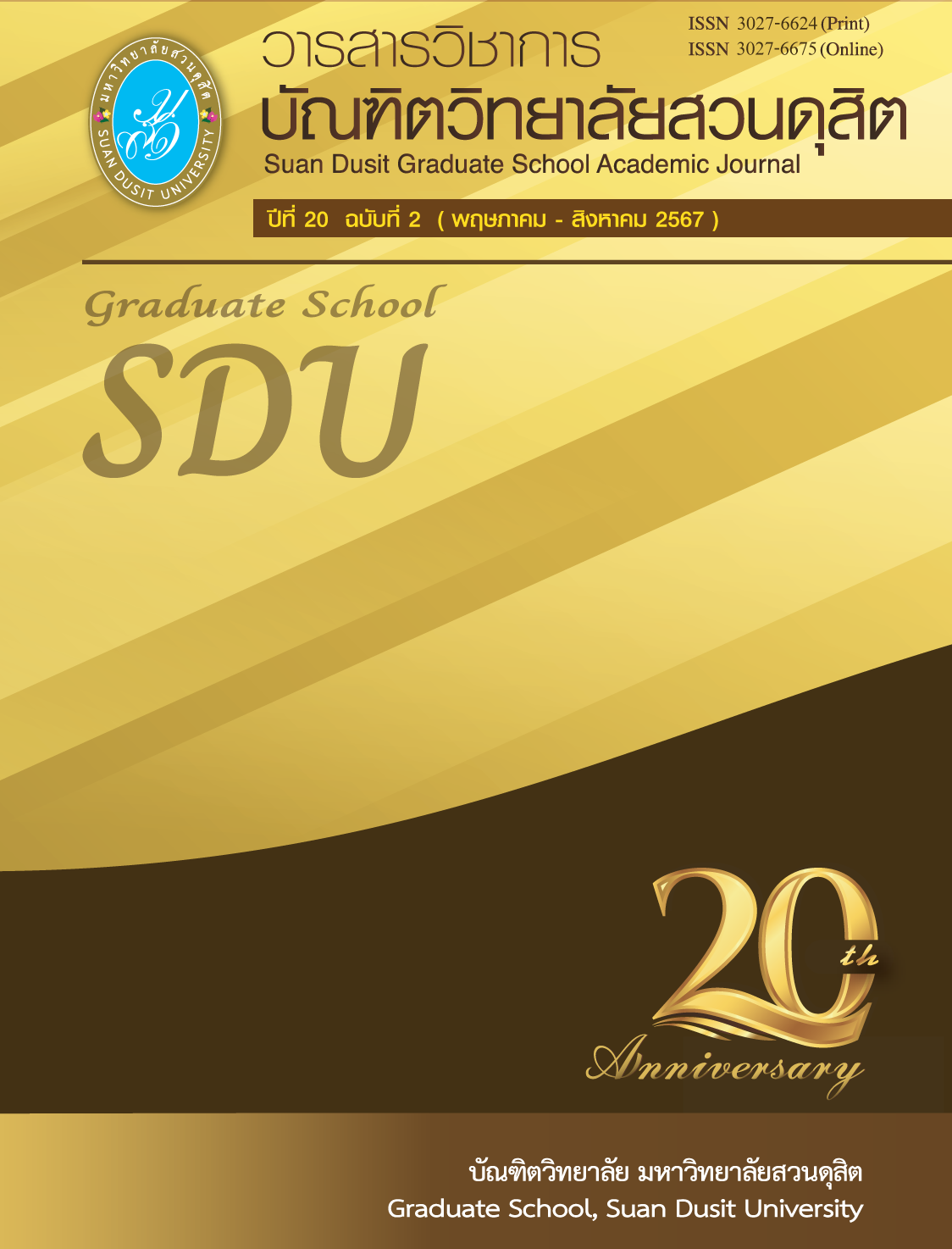Life Skills Development in School-Aged Children.
Keywords:
Life Skills Development, School-Aged Children, Basic Education LevelAbstract
In this article, the author presents the life skills development for school-aged children. It describes the meaning, importance, and focus of life skills development, including the synthesis of important components of life skills, the country's policies and programs related to the life skills development of children and young people in the basic education level. This study will enable all parties involved in child and youth development including school teachers and parents who are very close and play an important role in the life skills development to realize and recognize the importance of life skills development, especially in the current social conditions that are volatile and change rapidly including information, technology, communication, ethnic and cultural diversity as well as other social problems such as drug problems, violence, quarrels, untimely sex, etc. These problems affect the development of children and youth and the overall development of the country. Therefore, the promotion and development of life skills for children and youth in school age need to focus and comprise important life skills components such as decision-making skills, problem-solving skills, analytical skills, communicating and media realization skills, interpersonal skills, self-esteem and people recognition skills, emotional and stress management skills and adaptability and flexibility skills. These components are regarded as a learning management process that will enable students to deal with problems in life, as well as prepare for future adjustments in terms of knowledge, thoughts, attitudes and emotions. Therefore, the learners can have good life immunity, live consciously, be aware of the problem and choose to live safely and happily the society.
References
กรมสุขภาพจิต. (2561). เผยผลสำรวจพบวัยรุ่น กทม. ปริมณฑลครึ่งหนึ่งผูกติดความสุขตัวเองไว้กับแฟนแนะครอบครัวครูช่วยแนะทักษะชีวิตป้องกันพฤติกรรมเสี่ยง. สืบค้นเมื่อ 30 พฤษภาคม 2562 จาก https://www.dmh.go.th/news-dmh/view.asp?id=27571.
กรมสุขภาพจิต. (2558). การ์ตูนพัฒนาทักษะชีวิตสำหรับนักเรียนชั้น ป.4-6 และคู่มือประกอบการจัดกิจกรรมการเรียนรู้. นนทบุรี: กรมสุขภาพจิต กระทรวงสาธารณสุข.
กรมอนามัย. (2558). คู่มือการเรียนการสอนเรื่องเพศศึกษาและทักษะชีวิตในนักเรียนแบบบูรณาการ. นนทบุรี: สำนักอนามัยการเจริญพันธุ์ กรมอนามัย.
ไพฑูรย์ สินลารัตน์ และคณะ. (2557). โรงเรียนผลิตภาพ: สัตตทัศน์เพื่อการจัดการ. กรุงเทพฯ: จุฬาลงกรณ์มหาวิทยาลัย.
ไพฑูรย์ สินลารัตน์. (2558). ทักษะแห่งศตวรรษที่ 21 ต้องก้าวให้พ้นกับดักของตะวันตก. กรุงเทพฯ: จุฬาลงกรณ์มหาวิทยาลัย.
มติชน. (2560). เด็กไทยวันนี้ !! นักวิชาการจุฬาฯ แฉสถานการณ์เด็กไทยมีปัจจัยเสี่ยง 10 ด้าน “ความรุนแรงแม่วัยใส ยาเสพติด”. สืบค้นเมื่อ 2 ธันวาคม 2560 จาก https://www.matichon.co.th/news/418603.
ยงยุทธ วงศ์ภิรมย์ศานติ์ และสุวรรณา เรืองกาญจนเศรษฐ์. (2551). ทักษะชีวิต. กรุงเทพฯ: ศูนย์ส่งเสริมสุขภาพวัยรุ่น โรงพยาบาลรามาธิบดี.
วนิดา ขาวมงคล เอกแสงศรี. (2546). หลักการสอนการพัฒนาทักษะชีวิต. กรุงเทพฯ: จุฬาลงกรณ์มหาวิทยาลัย.
วิจารณ์ พานิช. (2557). การสร้างการเรียนรู้สู่ศตวรรษที่ 21. กรุงเทพฯ: มูลนิธิสยามกัมมาจล.
สกล วรเจริญศรี. (2550). การศึกษาทักษะชีวิตและการสร้างโมเดลกลุ่มฝึกอบรมเพื่อพัฒนาทักษะชีวิตของนักเรียนวัยรุ่น. ปริญญานิพนธ์การศึกษาดุษฎีบัณฑิต บัณฑิตวิทยาลัย มหาวิทยาลัยศรีนครินทรวิโรฒ.
สำนักปลัดกระทรวงศึกษาธิการ. (2553). คู่มือการฝึกอบรมหลักสูตรลูกเสือต้านภัยยาเสพติด. กรุงเทพฯ: สำนักการลูกเสือยุวกาชาด และกิจการนักเรียน สำนักปลัดกระทรวงศึกษาธิการ.
สำนักงานเลขาธิการสภาการศึกษา. (2559). สภาการศึกษาเสวนา (OEC Forum) 2015-2016 จากข้อเสนอสู่นโยบาย. กรุงเทพฯ: 21 เซ็นจูรี่.
สำนักงานเลขาธิการสภาการศึกษา. (2560). แผนการศึกษาแห่งชาติ พ.ศ. 2560-2579. กรุงเทพฯ: พริกหวานกราฟฟิค.
สถาบันแห่งชาติเพื่อการพัฒนาเด็กและครอบครัว มหาวิทยาลัยมหิดล. (2554). เข้าใจใส่ใจวัยรุ่น. สืบค้นเมื่อ 19 เมษายน 2561 จาก http://www.factsforlifethai.cf.mahidol.ac.th/teenager/support02.php.
สุดารัตน์ พิมลรัตนกานต์. (2558). ทักษะชีวิตและสังคม. กรุงเทพฯ: ซีเอ็ดยูเคชั่น.
สำนักงานคณะกรรมการการศึกษาขั้นพื้นฐาน. (2554). การเสริมสร้างทักษะชีวิตตามจุดเน้นการพัฒนาคุณภาพผู้เรียนระดับประถมศึกษา-มัธยมศึกษา. กรุงเทพฯ: ชุมนุมสหกรณ์การเกษตรแห่งประเทศไทย.
สำนักงานคณะกรรมการการศึกษาขั้นพื้นฐาน. (2558). แนวทางการจัดค่ายเสริมสร้างทักษะชีวิตเด็กไทย “ปัญหาหยุดยั้งด้วยพลังเด็กและเยาวชน”. กรุงเทพฯ: ชุมนุมสหกรณ์การเกษตรแห่งประเทศไทย.
สำนักงานคณะกรรมการการศึกษาขั้นพื้นฐาน. (2559). แนวทางการพัฒนาทักษะชีวิต. กรุงเทพฯ: สำนักงานพระพุทธศาสนาแห่งชาติ.
สมาคมแนะแนวแห่งประเทศไทย. (2559). การออกแบบกิจกรรมแนะแนวที่เน้นการพัฒนาทักษะสำหรับผู้เรียน. กรุงเทพฯ: ชุมนุมสหกรณ์การเกษตรแห่งประเทศไทย.
สำนักวิชาการและมาตรฐานการศึกษา. (2560). แนวทางการพัฒนาและประเมินค่านิยมหลักของคนไทย 12 ประการ. กรุงเทพฯ: ชุมนุมสหกรณ์การเกษตรแห่งประเทศไทย.
มูลนิธิไร้ท์ทูเพลย์. (2560). ทักษะชีวิตรหัสครูศตวรรษที่ 21: การจัดการเรียนการสอนเพื่อพัฒนาทักษะชีวิตแห่งศตวรรษที่ 21. สำนักงานคณะกรรมการการศึกษาขั้นพื้นฐาน กระทรวงศึกษาธิการ.
Andrew Steptoe and Jane Wardle (2017). Life skills, Wealth, Health, and Wellbeing in Later Life. Retrieved on April 16, 2019 from https://www.pnas.org/content/pnas/114/17/4354.full.pdf.
United Nations Children's Fund. (UNICEF, 2001). What is the Life Skills Approach?. Explore Ideas Articles, Opinions, and Research about Teaching and Learning. Retrieved on December 21, 2017 from http://www.unicef.org/teachers/teacher/Lifeskill/htm.
World Economic Forum. (2016). New Vision for Education: Fostering Social and Emotional Learning Through Technology. Retrieved on April 16, 2019 from: http://www3.weforum.org/docs/WEF_New_Vision_for_Education.pdf.
World Health Organization. (WHO, 1994). Life Skill Education in School. Geneva: World Health Organization.
World Health Organization. (WHO, 1997). Life Skills Education for Children and Adolescences in School. Geneva: Programme on Mental Health.
Downloads
Published
How to Cite
Issue
Section
License
Copyright (c) 2024 Graduate School, Suan Dusit University

This work is licensed under a Creative Commons Attribution-NonCommercial-NoDerivatives 4.0 International License.






